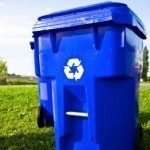Fill an old pillowcase with compost-ready materials from your
kitchen, tie the top with string, submerge the pillowcase for 24 hours in a
five-gallon bucket filled with water. Spread the nutrient-drenched contents on
your garden the next day and use the watery brine to water other plants.
The easiest way to do
your part and help the environment is to simply recycle. It’s also one of the
most effective ways to conserve natural resources, create less pollution and
reduce the amount of waste sent to the landfill.
Seventy-five percent of the waste we generate in American homes is recyclable
but less than 35% is actually making it to a recycling center. The following
steps are simple practices you can put into place to help you do your part and
make a habit of recycling.
Make It Easy: Most of us keep our recycling bins outside or
in the garage, which isn’t always convenient. Put other containers throughout
your home to serve as recycling bins—especially in places where it’s easy to
forget to recycle. One of those places is the bathroom. Think of all the empty
shampoo bottles, toilet paper rolls, and even those cardboard soap boxes that
usually get tossed in the trash. In your home office, have another basket to
collect paper for recycling. By spreading out small containers for recycling
around the house, the entire family will be more inclined to think twice before
throwing something in the garbage.
Know Your Numbers: All plastic containers have a little
number inside recycling arrows located on the bottom which identifies the type
of plastic used to make the product. Many local curbside recycling programs
accept products marked with a No. 1 or No. 2 but some take all seven types of
plastic.
It Makes Cents: Throwing aluminum cans in the trash is like
throwing money out the window. Recycled aluminum is turned into new cans in less
than 90 days and it can be recycled over and over again. It takes 95% less
energy to make a can from recycled materials and produces 97% less water
pollution. So choose beverages in aluminum and recycle every can.
Speak With Your Wallet: Filling your curbside-recycling bin
is just the beginning. Complete the circle by seeking out products made from
recycled content—especially post-consumer content. That’s the materials you
recycle and not the scraps on factory floors.

